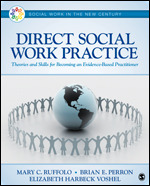Direct Social Work Practice
Theories and Skills for Becoming an Evidence-Based Practitioner
- Mary C. Ruffolo - The University of Michigan-Ann Arbor, USA
- Brian E. Perron, Ph.D. - The University of Michigan-Ann Arbor, USA
- Elizabeth Harbeck Voshel - The University of Michigan-Ann Arbor, USA
Series:
Social Work in the New Century
Social Work in the New Century
February 2015 | 280 pages | SAGE Publications, Inc
Using a case-based approach to connect the classroom and the practice environment, this foundational text incorporates a broad set of themes that include advocacy, social justice, global focus, ethics, theory, and critical thinking. Integrated, up-to-date content related to diversity, social justice, and international issues helps readers develop the basic skills of engagement, assessment, intervention, and reflective practice, as well as the key skills needed for the field experience. Each chapter of the book is mapped to the latest Educational Policy and Accreditation Standards (EPAS) to aid schools of social work in connecting the course content with monitored outcomes.
Chapter 1: An Overview of the Book
Chapter 2: Integrative Themes That Guide Social Work Practice with Individuals, Families, and Small Groups
Chapter 3: From Evidence-Based Practice to Evidence-Informed Practice
Chapter 4: Professional Values, Ethics, and Professional Use of Self
Chapter 5: Engagement and Relationship-Building Skills
Chapter 6: Assessment in Social Work With Individuals and Families
Chapter 7: Change Planning
Chapter 8: Core Intervention Skills: Using Cognitive and Behavioral Approaches in Social Work Practice With Individuals, Families, and Groups
Chapter 9: Intervention Skills: Using Problem-Solving, Psychoeducational, and Multisystemic Intervention Approaches and Case/Care Management Skills in Working With Individuals and Families
Chapter 10: Additional Skills for Working With Families and Groups
Chapter 11: Outcome Monitoring
Chapter 12: Lifelong Learning and Professional Development Over the Life Course
Supplements
Instructor Teaching Site
Password-protected Instructor Resources include the following:
- A Microsoft® Word® test bank is available containing multiple choice, true/false, short answer, and essay questions for each chapter. The test bank provides you with a diverse range of pre-written options as well as the opportunity for editing any question and/or inserting your own personalized questions to effectively assess students’ progress and understanding.
- A Respondus electronic test bank is available and can be used on PCs. The test bank contains multiple choice, true/false, short answer, and essay questions for each chapter and provides you with a diverse range of pre-written options as well as the opportunity for editing any question and/or inserting your own personalized questions to effectively assess students’ progress and understanding. Respondus is also compatible with many popular learning management systems so you can easily get your test questions into your online course.
- Editable, chapter-specific Microsoft® PowerPoint® slides offer you complete flexibility in easily creating a multimedia presentation for your course.
- EXCLUSIVE! Access to certain full-text SAGE journal articles that have been carefully selected for each chapter. Each article supports and expands on the concepts presented in the chapter. This feature also provides questions to focus and guide student interpretation. Combine cutting-edge academic journal scholarship with the topics in your course for a robust classroom experience.
- Lecture notes summarize key concepts on a chapter-by-chapter basis to help with preparation for lectures and class discussions.
- Sample course syllabi for semester and quarter courses provide suggested models for use when creating the syllabi for your courses.
- Lively and stimulating ideas for class assignments that can be used in class to reinforce active learning. The activities apply to individual or group projects.
- Case situation discussion questions help launch classroom interaction by prompting students to engage with the material and by reinforcing important content.
- Web resources are included for further research and insights.
Student Study Site
The open-access Student Study Site includes the following:
- Learning objectives reinforce the most important material.
- Mobile-friendly eFlashcards reinforce understanding of key terms and concepts that have been outlined in the chapters.
- Mobile-friendly web quizzes allow for independent assessment of progress made in learning course material.
- EXCLUSIVE! Access to certain full-text SAGE journal articles have been carefully selected for each chapter. Each article supports and expands on the concepts presented in the chapter. This feature also provides questions to focus and guide your interpretation.
- Case situation discussion questions reinforce key concepts in each chapter for self-review.
- Web exercises direct you to useful and current web resources, along with creative activities to extend and reinforce learning or allow for further research on important chapter topics.
- Web resources are included for further research and insights.
I chose this book for my graduate class in social work, after reviewing several others, because of the author's inclusion of cultural competence, cross-racial social work and other cultural factors.
School Of Social Work, University Of Michigan
October 11, 2020
